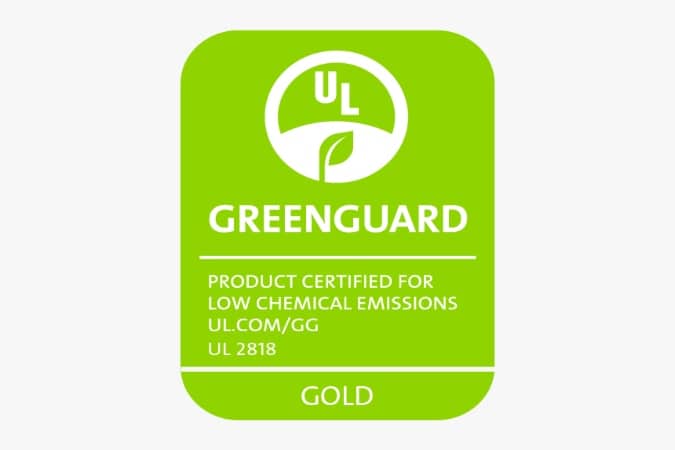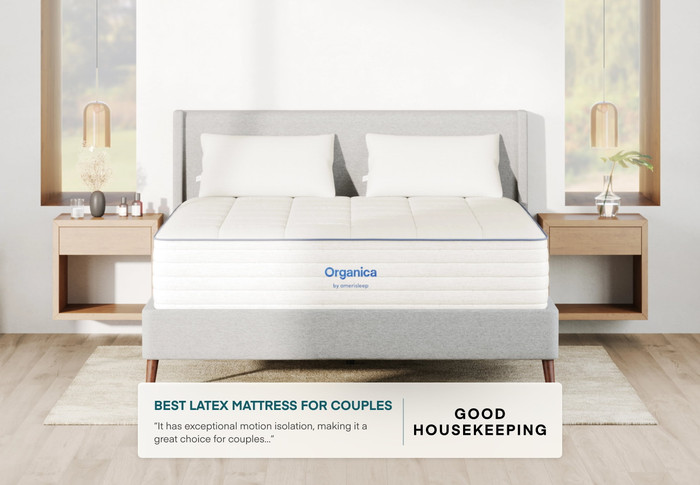When we shop for furniture, beds, and other decor, it’s not uncommon to see a Greenguard Gold logo on certain products. The green-colored logo certifies a product has low chemical emissions. The majority of our chemical exposure happens through the air we breathe, including indoor air.
To reduce exposure to air pollutants, we can rely on certifications like Greenguard Gold. The Greenguard Environmental Institute (GEI), corporately styled as GREENGUARD, offers certification programs to maintain low chemical emissions. The GEI is an industry-independent, third-party, non-profit organization, whose certifications are recognized globally. UL Environment, a global safety certification company, acquired the GEI in 2011.
In this article, we discuss the need for certifications, the various products tested under the Greenguard Certification Program, and its drawbacks.
Understanding the Need for Certifications
According to the United States Environmental Protection Agency Verified Source Environmental Protection Agency (EPA) Works to control/prevent natural and manmade disasters. View source (EPA), Americans, on average, spend 90 percent of their time indoors. Pollutants in indoor spaces can be five times denser than the outdoor air. This is caused due to chemical emissions from some of our regular household items.
These emissions happen when VOCs (Volatile Organic Compounds), present in certain products break down at room temperature. VOCs are carbon-based chemicals, which convert to gases and dissipate in the air. There can be 50 to 100 different VOCs in our indoor environment.
VOCs can be present in building materials, furniture, or even cleaning products. Be careful when choosing tiles, cabinets, mattresses, or even floor cleaners. They contain VOCs, which may be harmful to your health.
Some VOCs cause an off-gassing odor, common in a freshly painted room or a new mattress. This odor may cause nausea or breathlessness in some people, but it is not considered harmful. The health impact of VOCs depends on factors such as:
- The level of concentration
- The duration of exposure
- Individual sensitivities
- Ventilation of the room
There are no state or federal laws regulating VOC emissions, but many public health agencies and private programs recommend minimum exposure if possible.
Product Groups Tested Under UL Greenguard Certification Program
The UL Greenguard Certification Program offers two tiers of certification. The Greenguard Gold adheres to even stricter standards than the Greenguard certification criteria. For example, the Greenguard Certification allows 500 μg/m3 (micrograms per cubic meter of air) total VOCs. This is much more than the Greenguard Gold limit of only 220 μg/m3 total VOCs. The Gold standard even checks for additional chemicals. Opt for the Greenguard Gold Certification if you live with children, the elderly, or someone with a weak immune system.
The Greenguard and Greenguard Gold programs include rigorous standards of testing. The products are kept in dynamic environmental chambers for one to two weeks. These chambers are temperature and humidity-controlled stainless steel compartments, ensuring no VOCs.
After one or two weeks, the certifying agencies test the VOC levels in the chamber. If the emission levels are low, the products earn the Greenguard Gold or Greenguard Certification mark.
The UL Greenguard Certification Program tests the following types of products:
- Building materials, furniture, and furnishings
- Electronic equipment
- Cleaning and maintenance products
- Medical devices for breathing gas
Greenguard
A Greenguard Certified product is tested for over 10,000 chemicals and VOC emissions. It meets strict standards of low emission levels to maintain your indoor air quality.
Sometimes, high concentrations of certain VOCs can affect you. You may experience exhaustion, as well as eye, nose, or throat irritation. Greenguard Certified products can reduce these health risks, ensuring you breathe clean, chemical-free air.
The certifying agency reviews even the manufacturing process of the products. They test the products every year, ensuring consistent low emission levels.
Greenguard Gold
Greenguard Gold products emit lower VOCs than standard Greenguard products. In 2005, this certification was developed as the Greenguard Children and Schools Certification Program, certifying products for daycares, schools, and hospitals. In 2011, the name was changed to Greenguard Gold for a broader appeal.
Though children are more sensitive to chemicals, some adults may also need extra protection. Children breathe in a greater volume of air than adults, making them more sensitive to the effects of air pollution. Their organs and immune systems are in a developing stage. They can’t fight chemical pollutants as well as healthy adults.
Long term exposure to certain VOCs may lead to some health problems. Sometimes, Greenguard standards are outside of the scope for chemical contaminants. In such cases, a Greenguard Gold Certified product can help. For example, the formaldehyde levels in a Greenguard Gold Certified product have to be within 7.3 ppb (parts per billion). This is much lower compared to the 50 ppb limit in a standard Greenguard Certified product.
Formaldehyde exposure in children can have some serious health impacts. According to a 2010 National Library of Medicine study, Verified Source National Library of Medicine (NIH) World’s largest medical library, making biomedical data and information more accessible. View source it may trigger asthma and cause nasopharyngeal cancer. To allay these fears, some manufacturers opt for Greenguard Gold Certifications.
Greenguard Gold Certified products also meet the low VOC requirements of the State of California. The California Department of Public Health has developed a standard method of testing for the evaluation of VOC emissions. The Gold Standard program follows a similar method for testing their products.
The Downside of Greenguard Certification Programs
Though the Greenguard Gold Certification assures VOC levels within a certain threshold, knowing the exact amount of VOC emissions can be challenging. These numbers matter especially if you are sensitive to chemical emissions.
To find out the exact amount of VOC emissions, you need to contact the manufacturers, but once they have the Greenguard certification they don’t disclose the exact levels. This makes it difficult for shoppers who have specific chemical sensitivities. In such cases, it’s better to opt for companies willing to disclose chemical emission details of their products.
The Greenguard Gold Certification does not check for chemical contents in the material. It only measures the emissions from these chemicals.
Other Ways to Control Indoor Chemical Pollutants
- Whenever possible, open windows to allow fresh air circulation. This reduces the level of chemical concentration.
- Use indoor plants for healthy air quality. Some varieties, like aloe vera, absorb chemical emissions.
- Install an indoor air quality monitor. It checks the level of pollutants in your environment.
- Use an air purifier with activated carbon filters. These filters can remove harmful gases from indoor spaces.
- Check the total VOC emissions of a product before buying. Ask the customer service representatives for details.
- Turn on exhaust fans in the kitchen after cooking and cleaning. It dissipates the VOC emissions, improving air quality. Some also prefer to sleep with a fan on for fresh air in the bedroom, though others find the noise distracting.
FAQs
What is the Greenguard Gold Certification?
The Greenguard Gold Certification ensures the interior products are low in chemical emissions, decreasing indoor pollution levels. This program sets the most stringent guidelines for total VOC emissions. Greenguard Gold Certified products emit minimal gases. They maintain healthy indoor air quality, by reducing our chemical exposure.
How important is a Greenguard Gold certification?
If you have children or elderly in the house, a Greenguard Gold Certified product is a perfect choice because it limits chemical emissions. These low-emitting products don’t release significant chemical compounds into the air. They reduce the chances of chemical toxicity in our indoor spaces. This certification was specially developed for products used in schools and healthcare facilities.
Does Greenguard test for phthalates?
The standard Greenguard does not measure phthalates or mattress flame retardants. Phthalates are semi-volatile compounds, which don’t break down as fast as VOCs. Prolonged phthalate exposure may affect reproductive health. To limit this exposure, opt for the Greenguard Gold certification because it tests phthalates as well.
What is Greenguard?
It is an industry-independent, non-profit organization, also called the Greenguard Environment Institute (GEI). The GEI offers certification programs for products and buildings. The Greenguard Certification is accepted by sustainable building programs and in building codes worldwide.
The GEI focuses on reducing chemical emissions to improve indoor air quality. It was founded by Air Quality Sciences, Inc, an indoor air quality firm, in 2001. Ten years later, UL Environment acquired GEI, so now the programs are called UL Greenguard Certifications.
How Does Floorscore compare to GreenGuard?
Floorscore’s total VOCs limit is the same as standard Greenguard. If a product is Greenguard Gold Certified then it off-gasses less than Floorscore. Floorscore certifications are for hard surface flooring and flooring adhesives only.
Can VOCs make us sick?
It depends on individual sensitivities. Usually, VOCs from regular household products are not harmful, but some people may experience nausea, eye, nose, or throat irritation due to VOC emissions. Generally, children and the elderly are more at risk. Their immune systems are unable to fight infections caused by chemicals, making them more vulnerable to VOCs. Airing out certain products like furniture and mattresses limits the emissions.
Can plants absorb VOCs?
Yes, plants can absorb VOCs. Growing indoor plants is a great way to reduce chemical pollutants in your home. Peace lilies, aloe vera, and Chinese evergreens are excellent at cleaning indoor air. Aloe vera plants can even absorb VOCs like formaldehyde.
Conclusion
The Greenguard Gold certification is one of the best in the industry. It ensures you have a low-VOC emitting product but does not always guarantee clean air. Even Greenguard Gold Certified products emit some chemicals.
It’s always better to unpack your new furniture or mattress and keep it in a garage or an unused room for a few days. Air out new mattresses for 4 to 7 days, but be aware that some wooden or foam furniture may need more time. The VOCs usually dissipate within 1 to 2 weeks of airing out.
Apart from airing out products, follow other best practices such as growing indoor plants to reduce the effect of VOCs.
About the author
April Mayer is a sleep expert and writer with a degree in exercise physiology. She has dedicated her career to exploring the relationship between sleep and productivity. Her insightful articles, such as "The Surprising Way Your Mood Might Be Messing With Your Productivity" and "Wake Up to More Productive Mornings," have been featured in reputable publications like Forbes, Greatist, Real Homes, Thrillist, Tom's Guide, and Eat This, Not That. With a passion for helping others lead more productive lives through restful sleep, April offers valuable expertise on foods and vitamins for better sleep. As a trusted member of the Early Bird team since March 2020, she continues to provide informative and well-researched content.
View all posts





